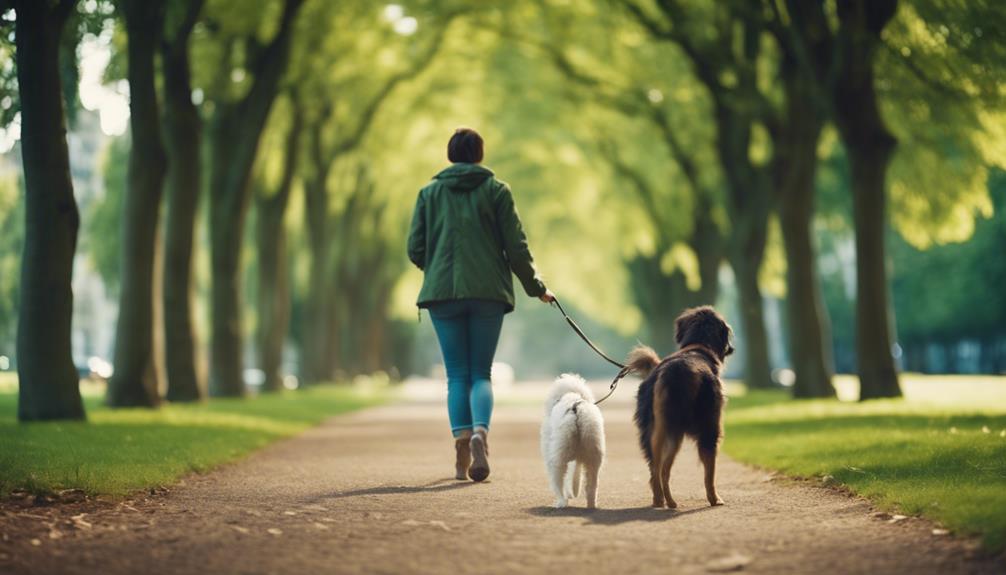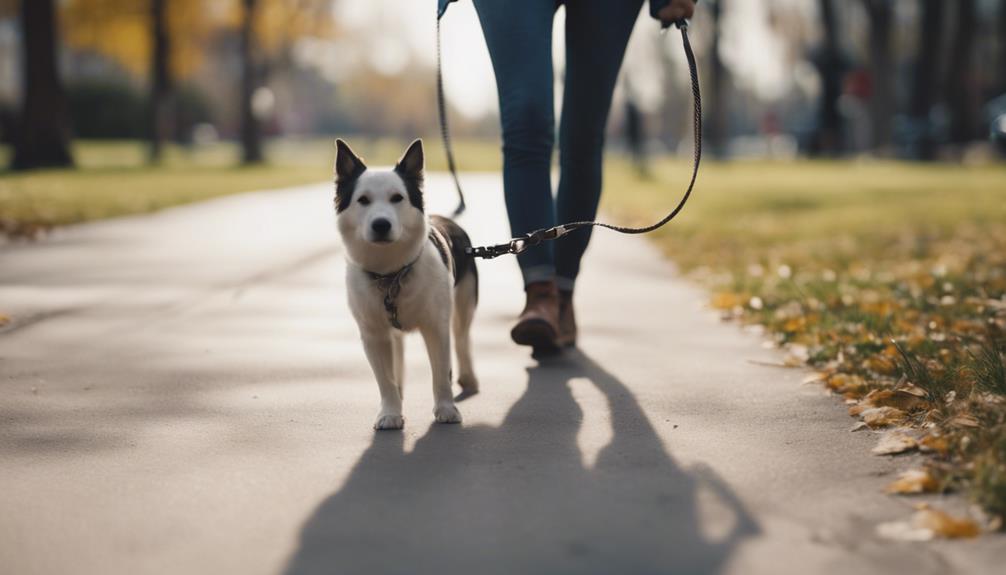When it comes to walking your dog, think of it as the key that unlocks a treasure trove of benefits for your furry companion's well-being.
But have you ever wondered if your pup's daily strolls are hitting the mark? Understanding the optimal frequency of walks tailored to your dog's unique needs is a puzzle worth solving.
Let's explore the secrets to keeping your four-legged friend happy, healthy, and eager for those outdoor adventures.
Key Takeaways
- Tailor your dog's walks based on age, size, and health conditions for optimal exercise.
- Adjust exercise for puppies, seniors, and large breeds to prevent health issues.
- Consider indoor activities for overstimulated dogs and avoid extreme weather conditions for walks.
- Equip yourself with appropriate gear and consult a vet for safe exercise levels tailored to your dog's health.
Importance of Daily Dog Walks
Daily dog walks are crucial for maintaining your furry friend's physical health and mental well-being. Regular walks help prevent obesity, improve cardiovascular health, and strengthen muscles. They also provide mental stimulation, reduce boredom, and reinforce the bond between you and your dog.
During walks, your dog explores new scents, sights, and sounds, which can alleviate stress and anxiety. Additionally, the exercise from walks helps regulate your dog's energy levels, leading to better behavior at home. Remember, each walk should be an opportunity for your dog to exercise, socialize, and engage with their environment.
Tailoring Walks for Different Breeds
When tailoring walks for different breeds, consider the specific exercise needs and limitations of each breed. Some breeds require more physical activity than others, so it's essential to adjust your walks accordingly.
Here are some tips to tailor walks for different breeds:
- High-energy Breeds: Breeds like Border Collies or Huskies need longer and more stimulating walks to burn off excess energy.
- Brachycephalic Breeds: Dogs with short muzzles, like Bulldogs or Pugs, may struggle with intense exercise due to breathing difficulties.
- Toy Breeds: Smaller breeds such as Chihuahuas or Maltese may have shorter legs and tire more quickly, so shorter, more frequent walks are suitable.
Factors Impacting Exercise Frequency

Tailoring walks for different dog breeds based on their specific exercise needs and limitations plays a crucial role in determining the optimal frequency of exercise for your furry friend. Factors such as age, breed, size, and health conditions significantly impact how often you should walk your dog.
Puppies require gradual introduction to exercise and consistent leash training. Older dogs may benefit from shorter, more frequent walks as they age. Large breed dogs are prone to orthopedic issues and shouldn't be overexercised. Smaller dogs may tire more easily and need breaks during walks.
Consider your dog's individual needs, consult with a vet for guidance, and adjust the frequency of walks accordingly to ensure your pup stays healthy and happy.
Exercise Guidelines for Senior Dogs
For senior dogs, ensuring appropriate exercise levels is crucial for their health and well-being as they age. As your furry companion enters their golden years, here's what you should keep in mind:
- Adjust Intensity: Opt for low-impact exercises like gentle walks or swimming to protect aging joints.
- Shorter and More Frequent: Break up exercise sessions into shorter, more frequent outings to prevent fatigue.
- Consult Your Vet: Always consult your veterinarian to tailor a suitable exercise plan based on your senior dog's individual health needs.
Health Considerations for Dog Walking

Ensure your dog's health and safety during walks by considering important factors like weather conditions and their specific health needs. Extreme weather can pose risks, so avoid long walks in extreme heat or cold to prevent issues like heatstroke or hypothermia. Consult your vet to establish safe exercise levels based on your dog's health condition, especially if they've narrow airways or medical concerns.
Adjust walking routines based on your dog's individual needs, ensuring they're comfortable and not overexerted. By being mindful of these health considerations, you can help your pup stay happy and healthy during their walks.
Proper Gear for Dog Walks
To ensure your dog's comfort and safety during walks, selecting appropriate gear tailored to their size and physical needs is essential. When gearing up for a walk, keep these crucial items in mind:
- Collar or Harness: Choose a collar or harness that fits your dog properly to prevent discomfort and ensure control.
- Leash: Opt for a comfortable leash that allows you to maintain control without causing strain on your dog's neck.
- ID Tag: Always have your dog wear an ID tag with your contact information in case they get lost during the walk.
Selecting the right gear won't only enhance your dog's walking experience but also contribute to their safety and well-being.
Understanding Your Dog's Exercise Needs

Understanding how much exercise your dog needs daily is crucial for their overall health and well-being. Most adult dogs require between 30 minutes to two hours of exercise per day. Factors such as age, breed, size, and health status influence the amount of daily exercise needed.
Small breed, senior dogs, or those with medical conditions may require moderation in exercise. Overstimulated or stressed dogs might benefit from indoor activities instead of walks. Tailor your dog's exercise routine based on specific factors like age, size, and health conditions.
Always consider your dog's well-being and consult with a vet to determine safe exercise levels, especially if your dog has health issues. By understanding and meeting your dog's exercise needs, you can help them lead a healthier and happier life.
Creating a Positive Walking Experience
How can you make your dog's walks more enjoyable and positive for both of you? To enhance your walking experience with your furry friend, consider the following tips:
- Choose Varied Routes: Keep things interesting by exploring different paths and environments during your walks. This can stimulate your dog's senses and provide mental enrichment.
- Incorporate Interactive Play: Break up the walk with interactive play sessions like fetch or training exercises. This can strengthen your bond and add an element of fun to the outing.
- Use Positive Reinforcement: Reward good behavior with treats, praise, or favorite toys. Positive reinforcement can encourage desired behaviors and make the walk a rewarding experience for your dog.
Monitoring Weather for Safe Walks

Considering your dog's well-being, always check the weather before heading out for a walk to ensure a safe and comfortable outing for both of you. Extreme weather conditions can pose risks to your pup's health.
High temperatures can lead to heatstroke, while cold weather may cause hypothermia. Before your walk, check the temperature, wind conditions, and precipitation forecast.
On hot days, opt for walks during cooler times like early morning or evening. In colder weather, consider using doggy boots or a jacket for warmth. If it's raining heavily or there's a storm, it might be best to postpone the walk for safety.
Consulting a Vet for Exercise Advice
Before embarking on a new exercise regimen with your dog, seek guidance from a veterinarian to ensure their safety and well-being. It's crucial to consider your dog's specific needs and limitations before starting any physical activity. Here are some key reasons why consulting a vet for exercise advice is essential:
- Tailored Recommendations: Vets can provide personalized exercise recommendations based on your dog's breed, age, and health status.
- Identifying Risks: Vets can help identify any potential health risks or conditions that may affect your dog's ability to exercise safely.
- Preventative Measures: Vets can offer guidance on preventing injuries or exacerbating existing health issues during exercise sessions.
Training Tips for Leash Etiquette

To improve your dog's leash etiquette, practice consistent and positive reinforcement techniques during walks. Use treats or verbal praise to reward good behavior, such as walking calmly beside you without pulling.
Start training in a quiet, distraction-free environment before gradually introducing more stimulating surroundings. Keep the leash loose and maintain a relaxed posture to encourage your dog to follow suit. If your dog starts pulling, stop walking and wait for them to calm down before continuing.
Avoid yanking on the leash, as this can lead to negative associations with walking. With patience and consistency, your pup will learn proper leash manners and enjoy walks even more.
Preventing Overexertion in Small Breeds
When walking small breeds, ensure you monitor their energy levels to prevent overexertion. Small dogs can easily tire out due to their size and energy levels. To keep them safe and healthy during walks, consider the following:
- Frequent Breaks: Allow your small breed dog to rest and catch their breath during the walk.
- Shorter Walks: Opt for shorter walks at a slower pace to avoid overexerting your small pup.
- Watch for Signs: Keep an eye out for signs of fatigue such as lagging behind, excessive panting, or reluctance to continue.
Signs of Overexercising in Dogs

Watch out for these signs that indicate your dog may be overexercising. If your pup is showing reluctance to exercise, seems unusually tired, or is experiencing stiffness or limping, these could be red flags of overexertion.
Keep an eye out for excessive panting, drooling, or seeking out cool surfaces, as these may signal that your dog is overheated. Other signs to watch for include disorientation, vomiting, diarrhea, or changes in behavior.
It's essential to listen to your dog's cues and adjust their exercise routine accordingly. Consulting with a vet can help determine if your dog is getting the right amount of physical activity without overdoing it. Your furry friend's well-being is the top priority.
Maintaining a Consistent Walking Routine
Maintain a consistent walking routine for your dog to ensure they receive appropriate exercise without overexertion. Here are three key tips to help you establish and maintain a healthy walking routine:
- Set a Schedule:
- Establish a regular walking schedule that fits your dog's needs and your daily routine.
- Consistency is key to providing your dog with the necessary physical activity.
- Aim for at least one to two walks per day, depending on your dog's age, breed, and energy level.
- Monitor Your Dog's Behavior:
- Observe your dog's response to walks to ensure they aren't becoming overly tired or showing signs of discomfort.
- Adjust the duration and intensity of walks based on your dog's physical condition and energy levels.
- Be attentive to any changes in behavior that may indicate the need for adjustments in the walking routine.
- Enjoy Quality Time Together:
- Use walks as an opportunity to bond with your dog and strengthen your relationship.
- Engage in interactive activities during the walk to keep your dog mentally stimulated.
- Make the walking experience enjoyable for both you and your furry companion.
Conclusion
Make sure to prioritize your furry friend's exercise needs by tailoring their walks based on their breed, age, and health condition.
Daily walks are essential for keeping your pup happy and healthy, so be sure to provide them with the right amount of exercise to meet their unique requirements.
By following these guidelines and staying consistent with your walking routine, you can ensure that your dog stays in top shape and enjoys every walk with you.




